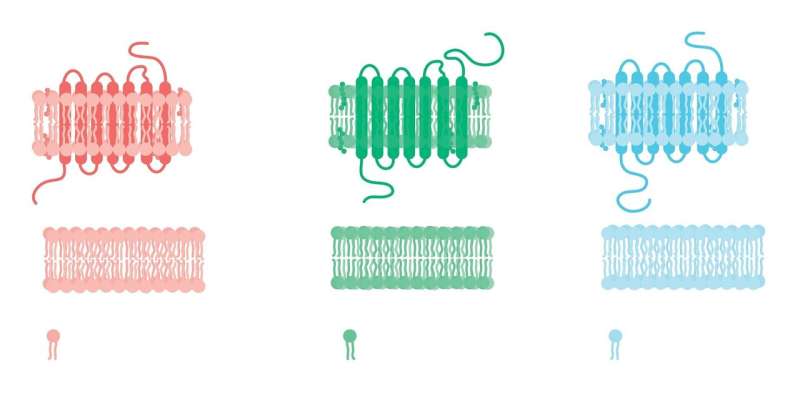Researchers find new signaling systems in human cells

One-third of all approved drugs target the same family of receptors: the G-protein-coupled receptors (GPCRs). Now, researchers from the University of Copenhagen, along with two American labs, have expanded the known network of peptides that activate GPCRs by 19 percent.
Human cells have a wide variety of receptors on the surface that many molecules and therapeutic drugs can bind to in order to activate signals inside the cell to regulate physiological functions. GPCRs are the largest and a very important family of receptors on human cells.
One-third of all approved drugs target GPCRs in one way or the other. However, for about one third of GPCRs the scientific community does not know which molecules—or ligands, as they are called—bind to the receptor and activate a signal.
Now, researchers from the University of Copenhagen, along with collaborators from the University of North Carolina at Chapel Hill and Thomas Jefferson University have discovered new signaling systems: five GPCRs activated by 17 peptide ligands. The new study, which is published in Cell, therefore expands the known peptide-GPCR network from 348 to 415 interactions, or by 19 percent in total.
"Researchers can spend their whole career studying one GPCR signaling system because their therapeutic potential is vast, as shown by the sheer number of medical drugs targeting them. In this study, we have identified five new such systems. In other words, this doesn't happen every day, and it might have huge implications for drug development," says lead author to the study David E. Gloriam, Professor at the Department of Drug Design and Pharmacology, UCPH.
Interdisciplinary effort
The researchers wanted to find peptides that function as signaling molecules because they represent around 71 percent of all known ligands that bind to GPCRs and they are increasingly tested in clinical trials. In short, peptides were a good place to start in the search for new signaling molecules.
Potential peptide ligands were identified from all the proteins in a cell, the so-called proteome, consisting of around 20,000 proteins. The researchers focused on those that are secreted from the cell, as peptides that work as signaling molecules need to be secreted. They then filtered out all those with a previously known function.
They then used machine learning to predict what potential peptides could be ligands for GPCRs. The calculations took into account genomes from more than 300 species and attempted to answer to what extent the peptides were "evolutionary conserved" or had the same characteristics as peptides in the species.
"In combining computational drug design with pharmacology, machine learning and genomics, we have used a truly collaborative method in order to identify these new aspects of human biology. We would not have been able to identify this many pairs had it not been for the interdisciplinary nature of our method," says Gloriam.
High translational potential
The researchers selected 218 potential ligands, which they screened against 21 receptors with three cutting-edge techniques to capture the different receptor responses: physical mass distribution inside the cell, internalization of the receptor in the cell and the recruitment of a protein called beta-arrestin. The researchers used three techniques because using only one might miss some signals that use other pathways. This work would not have been possible without collaborations with Professor Hans Bräuner-Osborne.
This comprehensive experimental process took over three years of lab work, and in the end, the researchers identified the five GPCRs paired with 27 peptide ligands. The genes of origin of the identified peptide ligands have previously been implicated in many diseases including genetic, nervous system and neoplastic disorders.
This suggests to the researchers that the identified signaling systems have high translational potential as therapeutic targets. They will now continue the research to investigate how each of the five signaling systems work and can affect human physiology.
More information: "Discovery of Human Signaling Systems: Pairing Peptides to G Protein-Coupled Receptors" Cell (2019). DOI: 10.1016/j.cell.2019.10.010 , www.cell.com/cell/fulltext/S0092-8674(19)31126-2
Journal information: Cell
Provided by University of Copenhagen



















